- cross-posted to:
- mycology@mander.xyz
- cross-posted to:
- mycology@mander.xyz
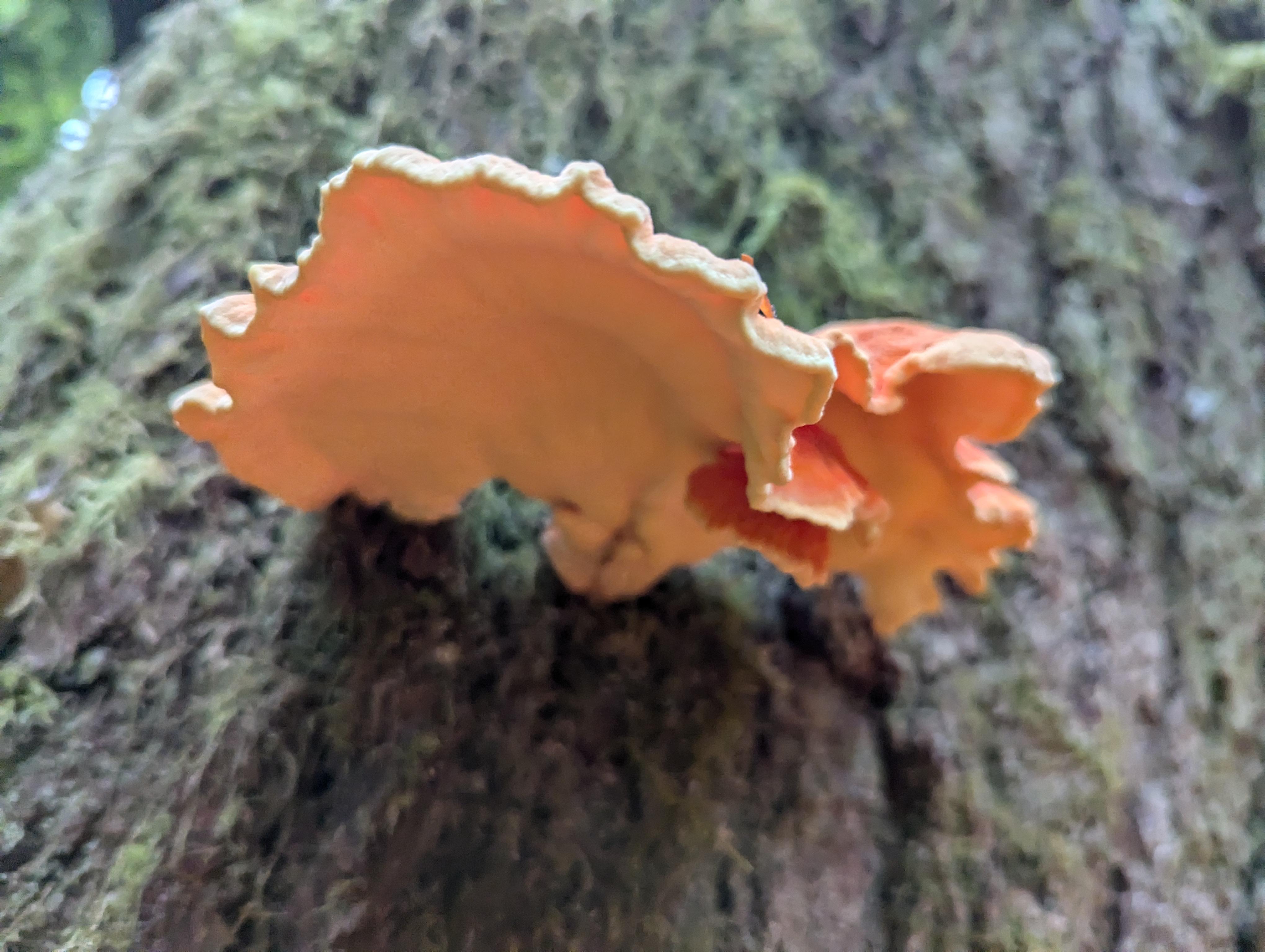
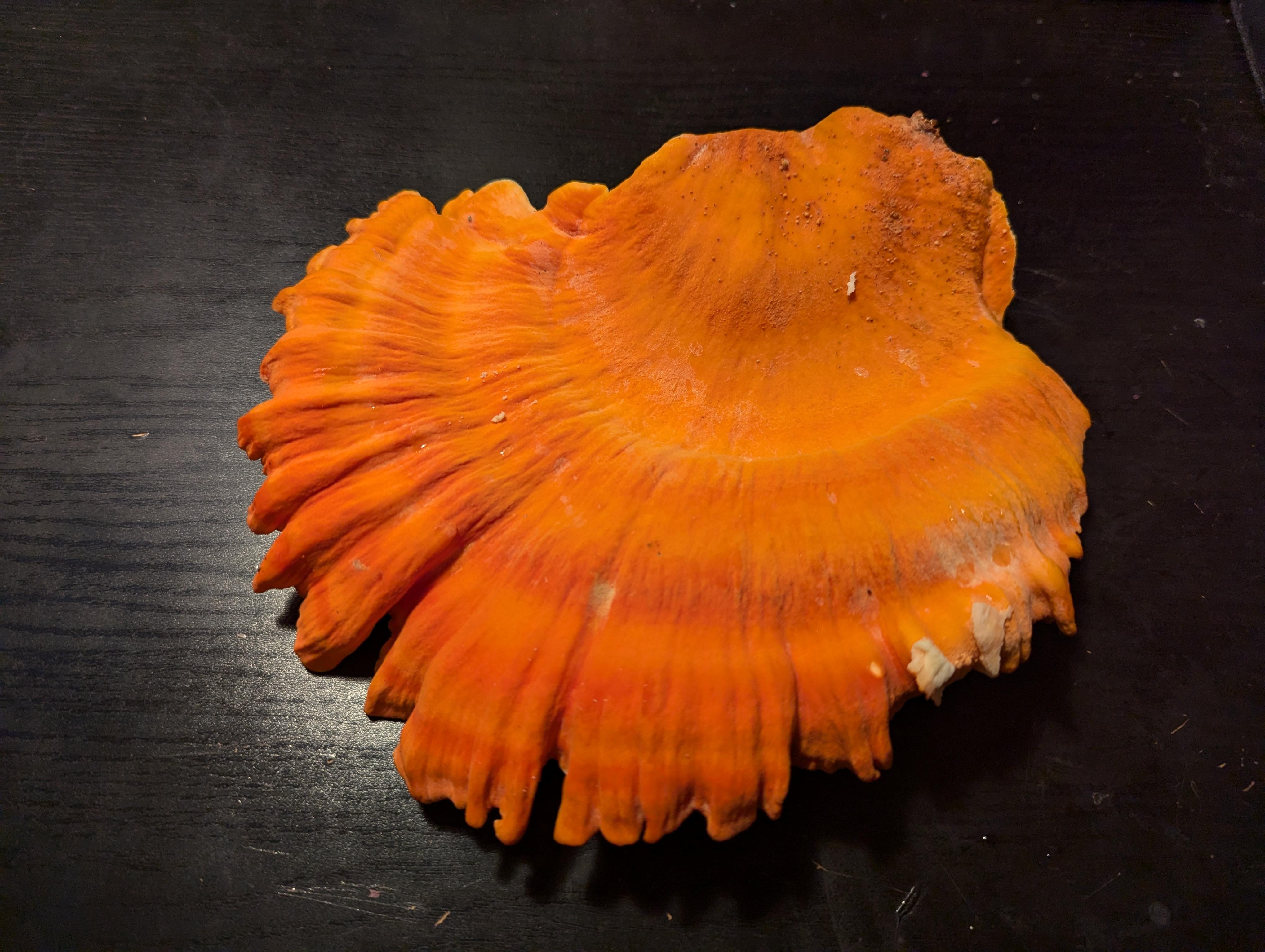
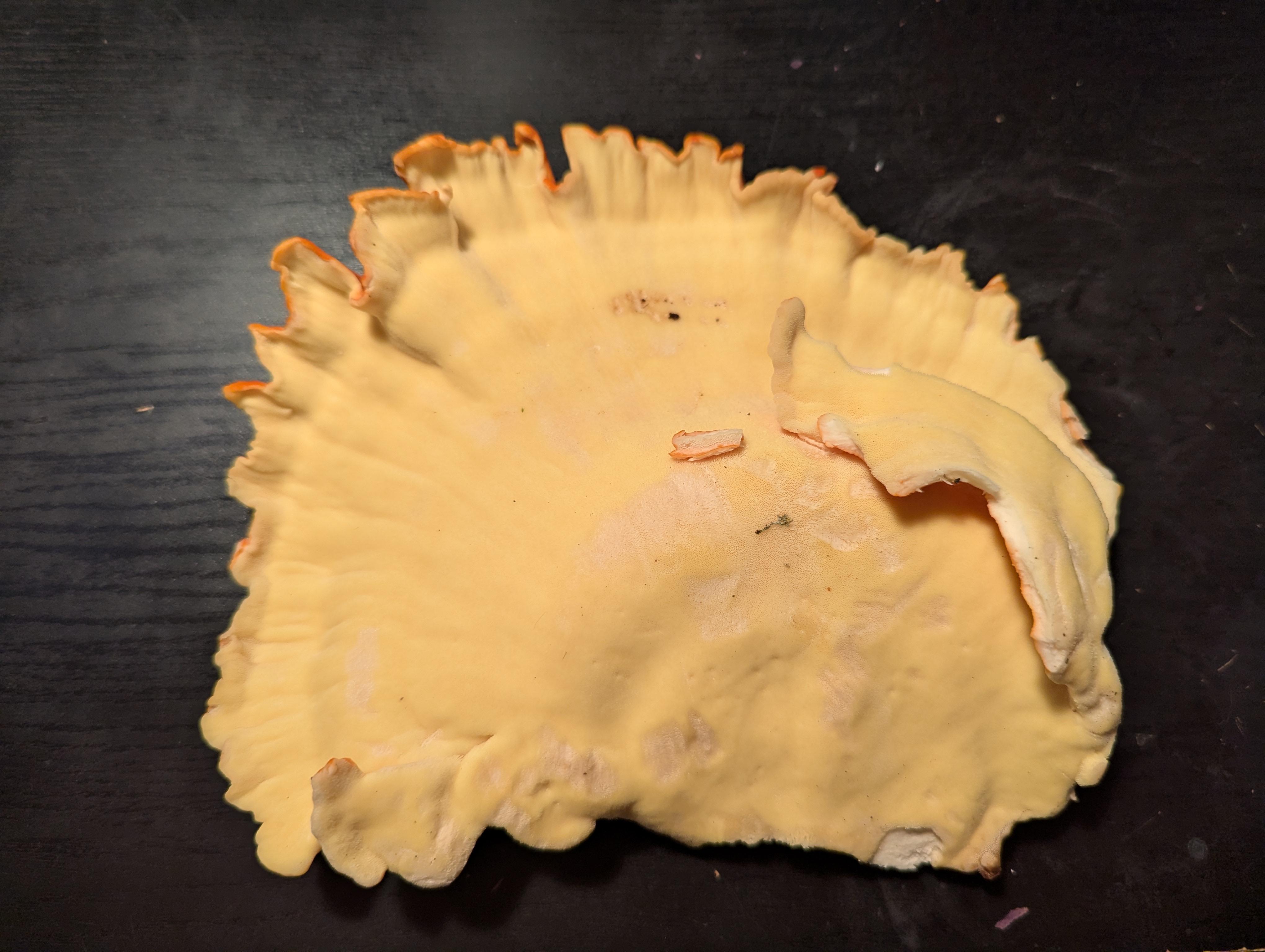
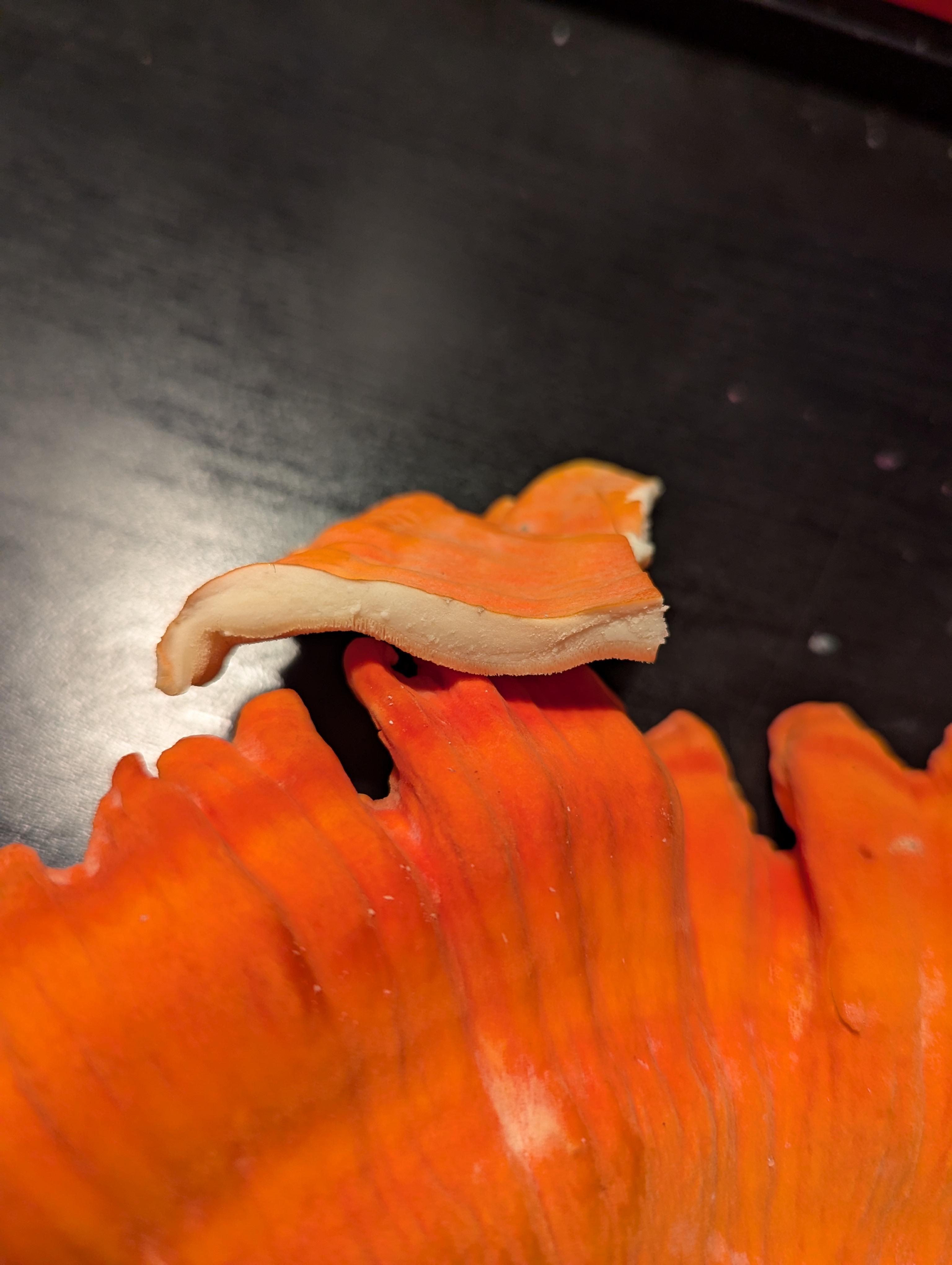
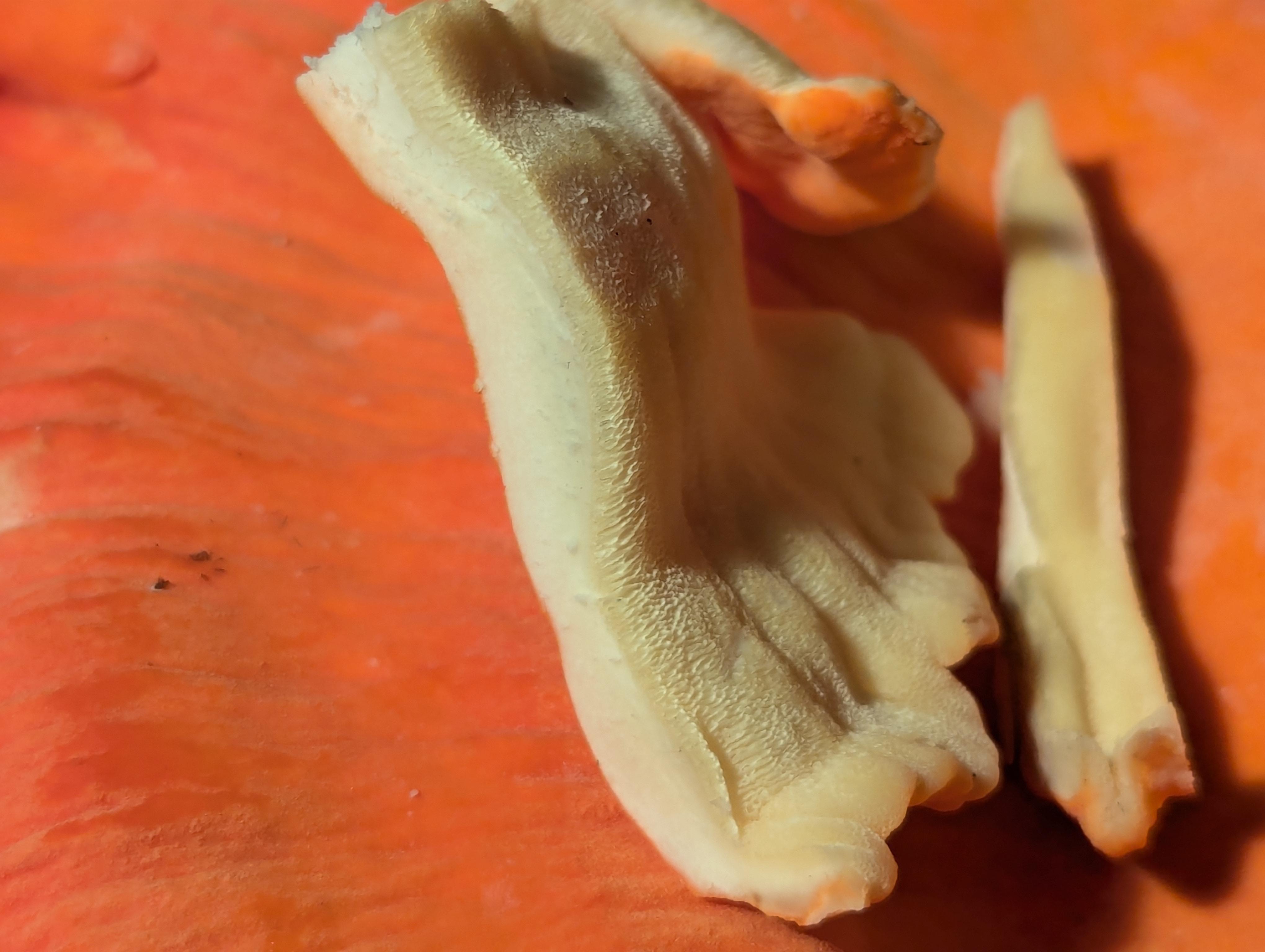
Found in Cascadia/PNW in mid-August.
If it is indeed chicken of the woods (ie laetiporus), I’m curious as to which species.
Cross-posts:
Definitely. Looks very fresh and delicious.
Just be aware that some people are sensitive to it and might react negatively to it. That might also be a myth, who knows.
Also, look at the tree it’s growing at. There are some species that can make COTW toxic, or at least inedible, making it bitter.
I really like to make chicken nuggets out of it, but using it just like chicken (e.g. fried rice) is extremely delicious!
deleted by creator
Looks like it’s a very lengthy process if you’re really doing it by the book…
That guide also says to avoid mushrooms altogether.
I think there’s a difference between “is this mushroom edible?” and “does this mushroom i know is edible agree with me?”
Most edible mushrooms are only edible after cooking. Important step. And really, you should positively identify anything before eating.
Some of the most common poisonous mushrooms have symptoms that don’t appear until 24 hours after eating them. I don’t recommend testing plants for poison like this unless you’re in an emergency situation.
Just be aware that some people are sensitive to it and might react negatively to it. That might also be a myth, who knows.
Also, look at the tree it’s growing at. There are some species that can make COTW toxic, or at least inedible, making it bitter.
From what I’ve read, it seems that some people are more sensitive to certain species of laetoporus. Regarding the substrate affecting the mushroom, this appears to be a common myth [1].
References
- David Arora. chickenofthewoods. “Conifer Chicken of the Woods… is it really inedible?”. mycology. Reddit. Published: 2022-10-08T02:10:01Z. (Accessed: 2024-08-18T00:56Z). https://www.reddit.com/r/mycology/comments/xz5myq/comment/irl3agr/.
There’s no evidence that substrate directly affects edibility but some kinds of chicken of woods favor conifers and others hardwoods. Warnings to avoid those on conifers originate in northeastern North America where those on hardwoods such as oaks have a better track record than the one on conifers. This does not apply to the west coast. Here is what I wrote earlier: Three things definitely matter: 1. Species. 2. Cooking. 3. Individual Sensitivity.
Species. We used to call them all Laetiporus sulphureus but recent research has shown five genetic clades within the genus Laetiporus in North America, and genes are the major determinant of toxicity of a mushroom. Two of the clades appear to produce a much higher incidence of GI poisonings. One of those clades grows on western conifers and on northeastern conifers. The second clade grows on hardwoods in the West and along the Gulf Coast. The other three clades grow on hardwoods in eastern North America and are not as likely to cause problems. In other words, all of our western chicken of the woods belong to the two problematic clades.
Cooking. Long and thorough cooking will reduce the chances of GI upset but not eliminate the possibility entirely (see #3). Ken Litchfield in SF did some experiments with small groups of people and found that the “puke factor” was eliminated by boiling the mushrooms first for 15 minutes, and that as he reduced the boil time nausea was more likely to occur.
Individual Sensitivity. There are many cases where groups of people dined on chicken of the woods and some but not all of them got sick. So obviously individual sensitivity plays a role, and it can work both ways. Some people can get away with cooking them very little, for instance, a five minute sauté (a woman from Alaska recommended that recently on this forum), but I wouldn’t do that for dinner guests. In the Litchfield experiment cited above, no one was made ill by the ones boiled for 15 minutes, but it was a small group of people so not necessarily representative of the general population. I do know cases of people who boiled them for a long time and still got sick, so for those few people it is flat-out poisonous. But prolonged cooking definitely makes it palatable for more people.
- David Arora. chickenofthewoods. “Conifer Chicken of the Woods… is it really inedible?”. mycology. Reddit. Published: 2022-10-08T02:10:01Z. (Accessed: 2024-08-18T00:56Z). https://www.reddit.com/r/mycology/comments/xz5myq/comment/irl3agr/.
Definitely chicken of the woods. Looks a little different than the species in my neck of the woods. Main thing to look out for in the pnw, from what I remember, is to make sure you aren’t harvesting them off of pacific yew, cause then it can absorb the toxins from that. Yours definitely isn’t on a yew, though.
make sure you aren’t harvesting them off of pacific yew, cause then it can absorb the toxins from that.
Is that due to some mechanism unique to a pacific yew? From what I’ve read, at least when talking about possible toxicity when found growing on a conifer, it’s mostly a myth, or at least misinformed [1].
References
- chickenofthewoods. “Conifer Chicken of the Woods… is it really inedible?”. mycology. Reddit. Published: 2022-10-08T02:10:01Z. (Accessed: 2024-08-18T00:56Z). https://www.reddit.com/r/mycology/comments/xz5myq/comment/irl3agr/.
There’s no evidence that substrate directly affects edibility but some kinds of chicken of woods favor conifers and others hardwoods. Warnings to avoid those on conifers originate in northeastern North America where those on hardwoods such as oaks have a better track record than the one on conifers. This does not apply to the west coast. Here is what I wrote earlier: Three things definitely matter: 1. Species. 2. Cooking. 3. Individual Sensitivity.
Species. We used to call them all Laetiporus sulphureus but recent research has shown five genetic clades within the genus Laetiporus in North America, and genes are the major determinant of toxicity of a mushroom. Two of the clades appear to produce a much higher incidence of GI poisonings. One of those clades grows on western conifers and on northeastern conifers. The second clade grows on hardwoods in the West and along the Gulf Coast. The other three clades grow on hardwoods in eastern North America and are not as likely to cause problems. In other words, all of our western chicken of the woods belong to the two problematic clades.
Cooking. Long and thorough cooking will reduce the chances of GI upset but not eliminate the possibility entirely (see #3). Ken Litchfield in SF did some experiments with small groups of people and found that the “puke factor” was eliminated by boiling the mushrooms first for 15 minutes, and that as he reduced the boil time nausea was more likely to occur.
Individual Sensitivity. There are many cases where groups of people dined on chicken of the woods and some but not all of them got sick. So obviously individual sensitivity plays a role, and it can work both ways. Some people can get away with cooking them very little, for instance, a five minute sauté (a woman from Alaska recommended that recently on this forum), but I wouldn’t do that for dinner guests. In the Litchfield experiment cited above, no one was made ill by the ones boiled for 15 minutes, but it was a small group of people so not necessarily representative of the general population. I do know cases of people who boiled them for a long time and still got sick, so for those few people it is flat-out poisonous. But prolonged cooking definitely makes it palatable for more people.
I’m sure I read it somewhere, but I just checked one of my books, and it doesn’t say that, and reading online, I can’t find anything with evidence either way. Seems like the main risk is of you don’t clean them very well and get a lot of plant matter encased in it. Doesn’t take much yew to make you sick.
Either way, though, thanks for calling me out! I don’t live near any yews, so it’s not something I’ve ever had to think about.
Seems like the main risk is of you don’t clean them very well and get a lot of plant matter encased in it. Doesn’t take much yew to make you sick.
I’ve heard that one is only supposed to eat the newest/youngest growth on chicken of the woods (the portion along the edge) [1.1][2]. The older/woodier growth towards the middle, and, by extension, the anchor to the substrate where the potentially troublesome plant matter might still be attached, shouldn’t be eaten as it has a higher likelihood of causing gastric upset [1.2].
References
- “Foraging and Cooking Chicken of the Woods Mushrooms”. Paul Stamets. YouTube. Published: 2020-09-06 (Accessed: 2024-08-19T00:38Z). https://www.youtube.com/watch?v=9K8HuTHTyP8
-
- T00:00:44
this mushroom is — it tastes like chicken […] especially on the first two inches of the margin.
- T00:00:53
[Chicken of the woods] sours with bacteria very quickly. And so I caution you not to eat the interiors or where it’s discolored.
- T00:00:44
- T00:01:00
here are signs of bacteria growing so this can cause GI upset
-
- “Chicken Of The Woods: A Guide To Sulphur Shelf Mushrooms in British Columbia”. Vancouver Island Mushrooms. Published: 2024-03-25T09:54:59 (Accessed: 2024-08-19T00:47Z). https://www.westcoastforager.com/wild-edible-mushrooms/chicken-of-the-woods.
-
only the most tender parts of the mushroom near the margin should be eaten.
-
Starting at their base, chicken of the woods mushrooms become pale and the texture becomes more like cork as they get older.
-
- “Foraging and Cooking Chicken of the Woods Mushrooms”. Paul Stamets. YouTube. Published: 2020-09-06 (Accessed: 2024-08-19T00:38Z). https://www.youtube.com/watch?v=9K8HuTHTyP8
- chickenofthewoods. “Conifer Chicken of the Woods… is it really inedible?”. mycology. Reddit. Published: 2022-10-08T02:10:01Z. (Accessed: 2024-08-18T00:56Z). https://www.reddit.com/r/mycology/comments/xz5myq/comment/irl3agr/.
There is a lot of discussion and debate around this genus and under what conditions it is edible. From what I’ve seen, there is no evidence that the host species has any direct effect on edibility, but the species may. In general, the species in the Eastern US are more edible than the western species.
This is most likely Laetiporus conifericola, which is sometimes consumed but can cause stomach illness in some people. I would recommend cooking thoroughly and eating a small quantity to see how your body handles it.
Just to supplement that with another source that I found during my research:
- David Arora. chickenofthewoods. “Conifer Chicken of the Woods… is it really inedible?”. mycology. Reddit. Published: 2022-10-08T02:10:01Z. (Accessed: 2024-08-18T00:56Z). https://www.reddit.com/r/mycology/comments/xz5myq/comment/irl3agr/.
There’s no evidence that substrate directly affects edibility but some kinds of chicken of woods favor conifers and others hardwoods. Warnings to avoid those on conifers originate in northeastern North America where those on hardwoods such as oaks have a better track record than the one on conifers. This does not apply to the west coast. Here is what I wrote earlier: Three things definitely matter: 1. Species. 2. Cooking. 3. Individual Sensitivity.
Species. We used to call them all Laetiporus sulphureus but recent research has shown five genetic clades within the genus Laetiporus in North America, and genes are the major determinant of toxicity of a mushroom. Two of the clades appear to produce a much higher incidence of GI poisonings. One of those clades grows on western conifers and on northeastern conifers. The second clade grows on hardwoods in the West and along the Gulf Coast. The other three clades grow on hardwoods in eastern North America and are not as likely to cause problems. In other words, all of our western chicken of the woods belong to the two problematic clades.
Cooking. Long and thorough cooking will reduce the chances of GI upset but not eliminate the possibility entirely (see #3). Ken Litchfield in SF did some experiments with small groups of people and found that the “puke factor” was eliminated by boiling the mushrooms first for 15 minutes, and that as he reduced the boil time nausea was more likely to occur.
Individual Sensitivity. There are many cases where groups of people dined on chicken of the woods and some but not all of them got sick. So obviously individual sensitivity plays a role, and it can work both ways. Some people can get away with cooking them very little, for instance, a five minute sauté (a woman from Alaska recommended that recently on this forum), but I wouldn’t do that for dinner guests. In the Litchfield experiment cited above, no one was made ill by the ones boiled for 15 minutes, but it was a small group of people so not necessarily representative of the general population. I do know cases of people who boiled them for a long time and still got sick, so for those few people it is flat-out poisonous. But prolonged cooking definitely makes it palatable for more people.
- David Arora. chickenofthewoods. “Conifer Chicken of the Woods… is it really inedible?”. mycology. Reddit. Published: 2022-10-08T02:10:01Z. (Accessed: 2024-08-18T00:56Z). https://www.reddit.com/r/mycology/comments/xz5myq/comment/irl3agr/.

